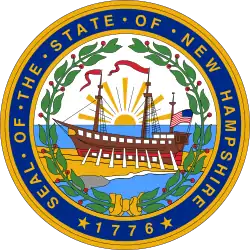Dover, New Hampshire
Dover is a city in Strafford County, New Hampshire, United States. The population was 29,987 at the 2010 census,[3] the largest in the New Hampshire Seacoast region and the 4th largest city in the state of New Hampshire. The population was estimated at 32,191 in 2019.[4] It is the county seat of Strafford County, and home to Wentworth-Douglass Hospital, the Woodman Institute Museum, and the Children's Museum of New Hampshire.
Dover, New Hampshire | |
|---|---|
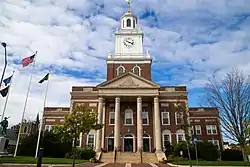 City Hall | |
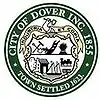 Seal | |
| Nickname(s): The Garrison City | |
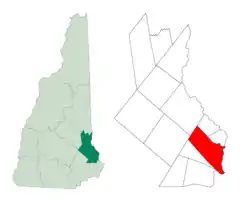 Location within New Hampshire | |
| Coordinates: 43°11′41″N 70°52′30″W | |
| Country | United States |
| State | New Hampshire |
| County | Strafford |
| Settled | 1623 |
| Incorporated | 1623 (town) |
| Incorporated | 1855 (city) |
| Government | |
| • Mayor | Robert Carrier |
| • City Council | Members
|
| • City Manager | Michael Joyal |
| Area | |
| • Total | 29.04 sq mi (75.22 km2) |
| • Land | 26.73 sq mi (69.23 km2) |
| • Water | 2.31 sq mi (5.99 km2) 7.96% |
| Elevation | 50 ft (15 m) |
| Population (2010) | |
| • Total | 29,987 |
| • Estimate (2019)[2] | 32,191 |
| • Density | 1,204.30/sq mi (464.99/km2) |
| Time zone | UTC−5 (EST) |
| • Summer (DST) | UTC−4 (EDT) |
| ZIP codes | 03820-03822 |
| Area code(s) | 603 |
| FIPS code | 33-18820 |
| GNIS feature ID | 0866618 |
| Website | www |
Etymology
First recorded in its Latinised form of Portus Dubris, the name derives from the Brythonic word for waters (dwfr in Middle Welsh). The same element is present in the town's French (Douvres) and Modern Welsh (Dofr) forms.
History
Settlement
The first known European to explore the region was Martin Pring from Bristol, England, in 1603. In 1623, William and Edward Hilton settled Cochecho Plantation, adopting its Abenaki name, making Dover the oldest permanent settlement in New Hampshire, and seventh in the United States.[5] One of the colony's four original townships, it then included Durham, Madbury, Newington, Lee, Somersworth and Rollinsford.
The Hiltons' name survives at Hilton Park on Dover Point (which was originally known as Hilton Point), where the brothers settled near the confluence of the Bellamy and Piscataqua rivers. They were fishmongers sent from London by The Company of Laconia to establish a colony and fishery on the Piscataqua. In 1631, however, it contained only three houses. William Hilton built a salt works on the property (salt-making was the principal industry in his hometown of Northwich, England). He also served as Deputy to the General Court (the colonial legislature).[6][7][8]
In 1633, Cochecho Plantation was bought by a group of English Puritans who planned to settle in New England, including Viscount Saye and Sele, Baron Brooke and John Pym. They promoted colonization in America, and that year Hilton's Point received numerous immigrants, many from Bristol. They renamed the settlement Bristol. Atop the nearby hill they built a meetinghouse surrounded by an entrenchment, with a jail nearby.[9]
Incorporation
The town was called Dover in 1637 by the new governor, Reverend George Burdett. It was possibly named after Robert Dover, an English lawyer who resisted Puritanism.[10] With the 1639 arrival of Thomas Larkham, however, it was renamed after Northam in Devon, where he had been preacher. But Lord Saye and Sele's group lost interest in their settlements, both here and at Saybrook, Connecticut, when their plan to establish a hereditary aristocracy in the colonies met disfavor in New England. Consequently, the plantation was sold in 1641 to Massachusetts and again named Dover.
Settlers built fortified log houses called garrisons, inspiring Dover's nickname "The Garrison City." The population and business center shifted upriver from Dover Point to Cochecho Falls, its drop of 34 feet (10 m) providing water power for industry (Cochecho means "the rapid foaming water.")[11]
Cochecho Massacre
On June 28, 1689, Dover suffered a devastating attack by Native Americans. It was revenge for an incident on September 7, 1676, when 400 Native Americans were tricked by Major Richard Waldron into performing a "mock battle" near Cochecho Falls. After discharging their weapons, the Native American warriors were captured. Half were sent to Massachusetts for predations committed during King Philip's War, then either hanged or sold into slavery. Local Native Americans deemed innocent were released, but considered the deception a dishonorable breach of hospitality. Thirteen years passed. When colonists thought the episode forgotten, they struck. Fifty-two colonists, a quarter of the population, were either captured or slain.
During Father Rale's War, in August and September 1723, there were Indian raids on Saco, Maine and Dover, New Hampshire.[12] The following year Dover was raided again and Elizabeth Hanson wrote her captivity narrative.

Mill era
_said_he_is_14_years_old._He_does_not_look_it._6_A.M._Group_going..._-_NARA_-_523199.jpg.webp)
Located at the head of navigation, Cochecho Falls brought the Industrial Revolution to 19th-century Dover in a big way. The Dover Cotton Factory was incorporated in 1812, then enlarged in 1823 to become the Dover Manufacturing Company. In 1827, the Cocheco Manufacturing Company was founded (the misspelling a clerical error at incorporation), which in 1829 purchased the Dover Manufacturing Company. Expansive brick mills, linked by railroad, were constructed downtown. Incorporated as a city in 1855, Dover for a time became a leading national producer of textiles.
The mills were purchased in 1909 by the Pacific Mills of Lawrence, Massachusetts, which closed the printery in 1913 but continued spinning and weaving. During the Great Depression, however, textile mills no longer dependent on New England water power began moving to southern states in search of cheaper operating conditions, or simply went out of business. Dover's millyard shut in 1937, then was bought at auction in 1940 by the city itself for $54,000. There were no other bids. Now called the Cocheco Falls Millworks, its tenants include technology and government services companies, plus a restaurant.[13][14]
Modern era
With the closing of the mills, the downtown area of Dover sat vacant and lifeless for a long time. With the turn of the century, the city government began to revitalize the area. The Children's Museum of New Hampshire was brought into a disused mill building with a lease of $1 a year. Henry Law Park, a grassy waterfront stretch of land, was given a brand new playground. Small businesses moved into the mills, such as restaurants, toy stores, real estate offices, and barber shops. Old buildings have been refurbished or outright rebuilt to provide new housing. An $87.5 million high school was built to handle the influx of new residents retreating from the high housing prices in Portsmouth. Recently, a plan to develop the waterfront on the other side of the river from the traditional downtown area was approved for $6 million.[15][16]
Antique postcards
 The Old Corner c. 1892
The Old Corner c. 1892 Central Square c. 1905
Central Square c. 1905 Public Library c. 1907
Public Library c. 1907 Guppy House c. 1910
Guppy House c. 1910 Old Brick Schoolhouse c. 1910, once located near Pine Hill Cemetery
Old Brick Schoolhouse c. 1910, once located near Pine Hill Cemetery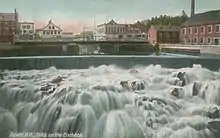 Cochecho Falls c. 1910
Cochecho Falls c. 1910 Whitcher's Falls c. 1910
Whitcher's Falls c. 1910 Pacific Mills c. 1912
Pacific Mills c. 1912 Downtown c. 1913
Downtown c. 1913
Geography and transportation

According to the United States Census Bureau, the city has a total area of 29.0 square miles (75.2 km2), of which 26.7 square miles (69.2 km2) is land and 2.3 square miles (6.0 km2) is water, comprising 7.96% of the city.[3] Dover is drained by the Cochecho and Bellamy rivers. Long Hill, elevation greater than 300 feet (91 m) above sea level and located 3 miles (4.8 km) northwest of the city center, is the highest point in Dover. Garrison Hill, elevation approximately 290 ft (88 m), is a prominent hill rising directly above the center city, with a park and lookout tower on top. Dover lies fully within the Piscataqua River (Coastal) watershed.[17]
The city is crossed by New Hampshire Route 4, New Hampshire Route 9, New Hampshire Route 16 (the Spaulding Turnpike), New Hampshire Route 16B, New Hampshire Route 108, New Hampshire Route 155, and U.S. Route 4. It is bordered by the town of Newington to the south (across the inlet to Great Bay), Madbury to the southwest, Barrington and Rochester to the northwest, Somersworth and Rollinsford to the northeast. South Berwick, Maine, lies to the northeast, across the tidal Salmon Falls River, and Eliot, Maine, is to the east, across the Piscataqua River.
The Cooperative Alliance for Seacoast Transportation (COAST) operates a publicly funded bus network in Dover and surrounding communities in New Hampshire and Maine.[18] C&J Trailways is a private intercity bus carrier connecting Dover with other coastal New Hampshire and Massachusetts cities, including Boston, as well as direct service to New York City.[19] Wildcat Transit, operated by the University of New Hampshire, provides bus service to Durham, which is free for students and $1.50 for the public.[20] Amtrak's Downeaster train service stops at the Dover Transportation Center with service to the Portland Transportation Center, Boston's North Station, and intermediate stops.
Demographics
| Historical population | |||
|---|---|---|---|
| Census | Pop. | %± | |
| 1790 | 1,998 | — | |
| 1800 | 2,062 | 3.2% | |
| 1810 | 2,228 | 8.1% | |
| 1820 | 2,871 | 28.9% | |
| 1830 | 5,449 | 89.8% | |
| 1840 | 6,458 | 18.5% | |
| 1850 | 8,196 | 26.9% | |
| 1860 | 8,502 | 3.7% | |
| 1870 | 9,294 | 9.3% | |
| 1880 | 11,687 | 25.7% | |
| 1890 | 12,790 | 9.4% | |
| 1900 | 13,207 | 3.3% | |
| 1910 | 13,247 | 0.3% | |
| 1920 | 13,029 | −1.6% | |
| 1930 | 13,573 | 4.2% | |
| 1940 | 13,990 | 3.1% | |
| 1950 | 15,874 | 13.5% | |
| 1960 | 19,131 | 20.5% | |
| 1970 | 20,850 | 9.0% | |
| 1980 | 22,377 | 7.3% | |
| 1990 | 25,042 | 11.9% | |
| 2000 | 26,884 | 7.4% | |
| 2010 | 29,987 | 11.5% | |
| 2019 (est.) | 32,191 | [2] | 7.3% |
As of the census of 2010, there were 29,987 people, 12,827 households, and 7,059 families residing in the city. The city grew by 3,103 residents between 2000 and 2010, the largest numeric growth of any town or city in New Hampshire. The population density in 2010 was 1,123.1 people per square mile (433.3/km2). There were 13,685 housing units at an average density of 512.5 per square mile (197.8/km2). The racial makeup of the city was 90.6% White, 1.7% African American, 0.20% Native American, 4.6% Asian, 0.05% Pacific Islander, 0.6% some other race, and 2.3% from two or more races. Hispanic or Latino of any race were 2.2% of the population.[22]
There were 12,827 households, out of which 27.8% had children under the age of 18 living with them, 40.8% were headed by married couples living together, 10.3% had a female householder with no husband present, and 45.0% were non-families. 31.8% of all households were made up of individuals, and 9.6% were someone living alone who was 65 years of age or older. The average household size was 2.27, and the average family size was 2.89.[22]
In the city, the population was spread out, with 20.3% under the age of 18, 11.0% from 18 to 24, 30.6% from 25 to 44, 24.9% from 45 to 64, and 13.1% who were 65 years of age or older. The median age was 36.7 years. For every 100 females, there were 96.0 males. For every 100 females age 18 and over, there were 94.0 males.[3]
For the period 2009–11, the estimated median annual income for a household in the city was $55,040, and the median income for a family was $69,980. Male full-time workers had a median income of $51,891 versus $36,167 for females. The per capita income for the city was $30,590. About 6.8% of families and 8.9% of the population were below the poverty line, including 13.2% of those under age 18 and 5.9% of those age 65 or over.[23]
Education
The Dover School District consists of approximately 4000 pupils, attending Horne Street Elementary School, Garrison Elementary School, Woodman Park Elementary School, Dover Middle School and Dover High School. Dover High's athletic teams are known as "The Green Wave," and the middle school's teams are "The Little Green."
Saint Mary Academy, a Catholic school, has been in downtown Dover since 1912, currently serving about 200 students from pre-kindergarten to 8th grade. Many students at Saint Mary's subsequently attend St. Thomas Aquinas High School, a Catholic high school located on Dover Point.
Portsmouth Christian Academy is located west of the Bellamy River in Dover, serving preschool through 12th grade.[24]
The Cocheco Arts and Technology Academy (CATA) is a public charter high school with about 100 students. It was formerly located in Barrington, New Hampshire.
The Seacoast Charter School is a publicly funded elementary/middle school that integrates the arts into the core curriculum. The school was founded in 2004 in Kingston, New Hampshire, and relocated to Dover in 2015. Enrollment in January 2016 was 215 students in grades K-8.[25]
Government
| Year | Democratic | Republican | Third Parties |
|---|---|---|---|
| 2020 | 65.19% 12,508 | 32.99% 6,331 | 1.80% 346 |
| 2016 | 58.17% 10,118 | 34.58% 6,015 | 7.25% 1,262 |
| 2012 | 59.85% 9,724 | 37.93% 6,162 | 2.22% 360 |
| 2008 | 63.17% 10,221 | 35.51% 5,746 | 1.32% 214 |
| 2004 | 59.39% 9,225 | 39.95% 6,206 | 0.66% 103 |
| 2000 | 54.32% 6,812 | 39.94% 5,008 | 5.74% 720 |
| 1996 | 56.38% 6,332 | 33.41% 3,752 | 10.21% 1,147 |
| 1992 | 45.45% 5,449 | 35.01% 4,197 | 19.54% 2,342 |
| 1988 | 46.59% 4,803 | 51.97% 5,357 | 1.44% 148 |
| 1984 | 41.32% 3,826 | 58.29% 5,397 | 0.39% 36 |
| 1980 | 35.14% 3,344 | 47.26% 4,497 | 17.60% 1,675 |
| 1976 | 49.53% 4,386 | 47.48% 4,204 | 2.99% 265 |
| 1972 | 42.94% 3,697 | 56.39% 4,855 | 0.66% 57 |
| 1968 | 51.12% 4,101 | 47.08% 3,777 | 1.81% 145 |
| 1964 | 68.53% 5,629 | 31.47% 2,585 | 0.00% 0 |
| 1960 | 52.34% 4,697 | 47.66% 4,277 | 0.00% 0 |
In the New Hampshire Senate, Dover is in the 4th District and is currently represented by Democrat David H. Watters. On the New Hampshire Executive Council, Dover is in District 2 and is currently represented by Democrat Andru Volinsky. In the U.S. House of Representatives, Dover is included in New Hampshire's 1st congressional district and is currently represented by Democrat Chris C. Pappas.
Dover is a Democratic stronghold in presidential elections. No Republican presidential nominee has carried Dover since George H.W. Bush’s five-point victory in the town over Michael Dukakis in 1988.
Notable people
In popular culture
Dover was used as the fictional setting for the Hallmark Channel movie Christmas Incorporated.
Dover was the birthplace of the Teenage Mutant Ninja Turtles franchise, created by comic book writers Kevin Eastman and Peter Laird and first published by Mirage Studios - then based in Dover - in 1984.
Historic sites
See also
- Dover (Amtrak station)
- McIntosh College
- 1987 Little League World Series, when a team from Dover advanced to the quarter-finals
References
- Notes
- "2019 U.S. Gazetteer Files". United States Census Bureau. Retrieved July 26, 2020.
- "Population and Housing Unit Estimates". United States Census Bureau. May 24, 2020. Retrieved May 27, 2020.
- "Geographic Identifiers: 2010 Demographic Profile Data (G001): Dover city, New Hampshire". U.S. Census Bureau, American Factfinder. Archived from the original on February 12, 2020. Retrieved February 11, 2013.
- "Annual Estimates of the Resident Population for Incorporated Places in New Hampshire: April 1, 2010 to July 1, 2019". U.S. Census Bureau. Retrieved May 21, 2020.
- Stackpole, Everett Schermerhorn (1916). History of New Hampshire. New York: The American Historical Society. ISBN 978-1-115-84294-5.
- Palmer, Ansell W., ed. Piscataqua Pioneers: Selected Biographies of Early Settlers in Northern New England, pp. 14, 17, 18, 29, 33, 63, 232-3, Piscataqua Pioneers, Portsmouth, NH, 2000. ISBN 0-9676579-0-3.
- Anderson, R. C. The Great Migration Begins: Immigrants to New England, 1620-1633, pp. 951-7, vol. 2, New England Historical and Genealogical Society, Boston, 1995.
- Scales, J. History of Dover, New Hampshire, pp. 311-13, facsimile of the 1923 edition, Heritage Books, 1989.
- Jeremy Belknap, The History of New Hampshire, 1812
- Haddon 2004, pp. 64–65
- Dover Public Library, "Is it Spelled Cochecho or Cocheco?" Archived 2015-07-07 at the Wayback Machine
- (William Williamson, p. 123)
- "Cocheco Falls Millworks". Cocheco Falls Millworks. Archived from the original on March 30, 2012. Retrieved August 15, 2011.
- Beaudoin, Cathleen. "A Yarn to Follow: The Dover Cotton Factory 1812—1821". Dover Public Library. Archived from the original on February 23, 2003. Retrieved August 15, 2011.
- "Dover's Economic Explosion". www.businessnhmagazine.com. Retrieved 2019-12-04.
- "Dover, N.H., reinvents itself into a destination - The Boston Globe". BostonGlobe.com. Retrieved 2019-12-04.
- Foster, Debra H.; Batorfalvy, Tatianna N.; Medalie, Laura (1995). Water Use in New Hampshire: An Activities Guide for Teachers. U.S. Department of the Interior and U.S. Geological Survey.
- "Take a closer look at COAST". www.coastbus.org. Retrieved 2010-07-06.
- "C&J: Connecting Dover, Durham, Portsmouth and Newburyport to Boston South Station and Logan Airport". www.ridecj.com. Retrieved 2010-07-06.
- "Wildcat Transit". Retrieved 2012-04-21.
- "Census of Population and Housing". Census.gov. Retrieved June 4, 2016.
- "Profile of General Population and Housing Characteristics: 2010 Demographic Profile Data (DP-1): Dover city, New Hampshire". U.S. Census Bureau, American Factfinder. Archived from the original on February 12, 2020. Retrieved February 11, 2013.
- "Selected Economic Characteristics: 2009-2011 American Community Survey 3-Year Estimates (DP03): Dover city, New Hampshire". U.S. Census Bureau, American Factfinder. Archived from the original on February 12, 2020. Retrieved February 11, 2013.
- "Portsmouth Christian Academy - In the News". www.pcaschool.org. Archived from the original on 2014-08-12. Retrieved 2010-07-06.
- "The Seacoast Charter School". Retrieved January 13, 2016.
- "Election Results". sos.nh.gov.
- Bibliography
- Haddon, Celia (2004), The First Ever English Olimpick Games, Hodder & Stoughton, ISBN 0-340-86274-2
External links
| Wikimedia Commons has media related to Dover, New Hampshire. |
| Wikivoyage has a travel guide for Dover, New Hampshire. |
| Wikisource has the text of a 1911 Encyclopædia Britannica article about Dover, New Hampshire. |

